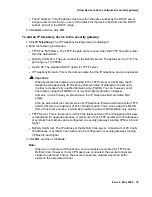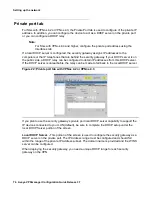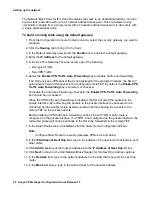
Setting up the network
88 Avaya VPNmanager Configuration Guide Release 3.7
About NAT types for VPNos 3.X
For VPNos 3.X, you can set the following types of NAT mapping on the VSU.
●
Static Mapping – Addresses from one network are permanently mapped to addresses on
another network. Static mapping works when traffic is initiated either inside or outside of
the private network.
●
Dynamic Mapping – Addresses from one network are temporarily mapped to an address
from another network. When traffic is initiated from a client on the private network, its
address is temporarily mapped to an address selected from a pool of public addresses.
When the client traffic is idle for a specified period of time, the mapped address is returned
to the pool of available addresses. When all public addresses have been assigned, no other
private clients can initiate traffic until a public address becomes available.
Dynamic mapping works only for connections initiated from the private network.
●
Port Mapping – This option is similar to dynamic mapping except that only one public IP
address is required. The security gateway maps every packet from the private network to
the public IP address and a source port selected from a predefined range of TCP and UDP
port numbers. When traffic is initiated from a client on the private network it is dynamically
mapped to the public IP address and an available port number.
When the client traffic is idle for a specified period of time, the port number is returned to the
pool of available port numbers. When all port numbers have been allocated, no other
private clients can initiate traffic until a port number becomes available.
Port mapping works only for connections initiated from the private network. In addition, port
mapping works only for TCP and UDP traffic.
NAT applications
Network administrators may choose to use the NAT mechanism for any of the following
reasons:
●
Allow access to the Internet from private networks. Networks which are assigned
private addresses, such as 10.0.0.0 (RFC 1918), or addresses that have not been
registered must be mapped to public addresses to allow users access to the Internet.
●
Provide support for more hosts with fewer public addresses. Address mapping allows
network administrators to increase the number of hosts that can access the Internet
without needing additional registered network addresses.
●
Hide host addresses for security reasons. Network administrators may choose to use
address mapping to hide actual host addresses from the public.
●
Set up VPNs that include overlapping private addresses. Address mapping allows
network administrators to set up VPNs between two sites that use the same private
network addresses. For example, both sites may be using 10.0.0.0 private network
addresses.
Содержание 3.7
Страница 1: ...VPNmanager Configuration Guide Release 3 7 670 100 600 Issue 4 May 2005...
Страница 4: ......
Страница 20: ...Preface 20 Avaya VPNmanager Configuration Guide Release 3 7...
Страница 32: ...Overview of implementation 32 Avaya VPNmanager Configuration Guide Release 3 7...
Страница 53: ...Preferences Issue 4 May 2005 53 Figure 16 Tunnel End Point Policy...
Страница 54: ...Using VPNmanager 54 Avaya VPNmanager Configuration Guide Release 3 7...
Страница 244: ...Using advanced features 244 Avaya VPNmanager Configuration Guide Release 3 7...
Страница 292: ...Upgrading firmware and licenses 292 Avaya VPNmanager Configuration Guide Release 3 7...
















































